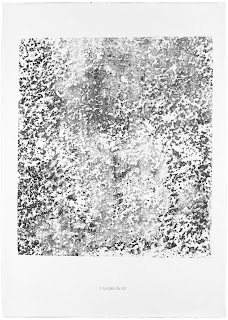「私が興味を持っているのはパンでありケーキではない。ごくまれにせいぜい小さなブリオッシュを一つ。パリではまず私のような人を紳士であると認めない。ケーキよりもパンを好むのはとても風変わりだと思われるから。ケーキよりもパンが好きになったなら、パティシエの機嫌を損ねることとなる。パティシエだけでなく、美術館、アートディーラー、美術評論家などの施設も。。。それらはまさにパリの名物であり、多くの人々の暮らしを支えてる。確かにケーキ博物館を作ることができる、しかしパン博物館を作るのは面白くない、パンはあまりにも日常的で変わり映えがしないから。一方ケーキに関しては、話題が尽きない。協議したり、またたくさんのお金を稼ぐことができるのだ。」
ジャン・デュビュッフェ「コーゼット」(1947)- 1947年にドルアンギャラリーでの展覧会のために書かれた記事
“Ce qui m’intéresse à moi ça n’est pas les gâteaux c’est le pain. Une fois de temps en temps un gâteau je ne dis pas non mais alors un petit gâteau modéré, une brioche tout au plus, qui se souvienne de sa farine et de son pétrin.
A Paris on admet ça difficilement qu’un monsieur soit comme ça, si excentrique d’aimer mieux le pain que les gâteaux. On pense alors que ça peut être pour faire l’intéressant, pour se faire remarquer. Ou bien plutôt pour faire une farce. On a très peur des farces à Paris. On est toujours en train de faire attention qu’on ne vous fasse pas une farce.
Si on se mettait à aimer mieux le pain que les gâteaux, ça porterait tort aux pâtissiers mais je ne veux pas dire seulement les pâtissiers mais aussi des institutions comme par exemple les musées, les marchands de tableaux, les critiques d’art, etc... qui sont justement une spécialité parisienne qui fait vivre beaucoup de monde. En effet on peut faire des musées de gâteaux mais des musées de pain on ne peut pas vu que le pain est très commun et somme toute toujours presque pareil, d’aspect peu varié. Sur les patisseries de grand gala et les belles pièces montées des déjeuners de noces on peut discourir et disputer à n’en plus finir, on peut conférencer, on peut faire des sectes et même financer des missions mais du moment que les gens viendraient à prendre cette idée, je veux dire mon idée ridicule, mon idée farce, que n’importe quel boulanger de campagne en sait plus long que tous ces clercs à haute toque, alors, ça ferait du chômage dans la profession...“
Jean Dubuffet, « Causette » (1947) - texte rédigé à l'occasion de l'exposition à la galerie Drouin en 1947
ここに掲載している文章と情報はステファン・エックオリジナルのものです。通常マナーとして、コピー&ペーストは控えてください。©2020 Stéphane Eck

